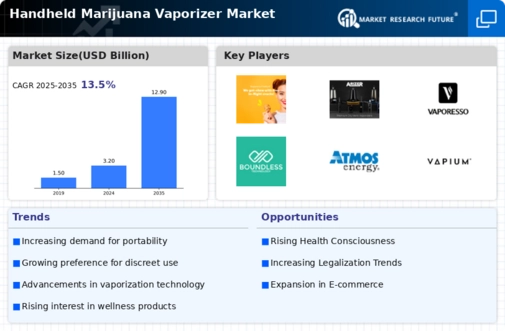Market Growth Projections
The Global Handheld Marijuana Vaporizer Market Industry is poised for substantial growth, with projections indicating an increase from 3.2 USD Billion in 2024 to 12.9 USD Billion by 2035. This growth trajectory suggests a robust compound annual growth rate (CAGR) of 13.53% from 2025 to 2035. Factors contributing to this expansion include increasing legalization, health-conscious consumer behavior, and technological advancements. The market's potential is further amplified by the rise of e-commerce and changing cultural attitudes towards cannabis. These dynamics collectively indicate a promising future for the industry, positioning it as a significant player in the broader cannabis market.
Health Conscious Consumer Behavior
A growing awareness of health and wellness among consumers is influencing the Global Handheld Marijuana Vaporizer Market Industry. Many users prefer vaporizers over traditional smoking methods due to perceived health benefits, such as reduced exposure to harmful toxins. This trend is particularly evident among younger demographics who prioritize healthier lifestyle choices. The market is likely to benefit from this shift, as vaporizers are often marketed as a cleaner alternative. As a result, the industry may experience a compound annual growth rate (CAGR) of 13.53% from 2025 to 2035, reflecting the increasing preference for health-conscious consumption.
Increasing Legalization of Cannabis
The ongoing trend of cannabis legalization across various regions appears to be a primary driver for the Global Handheld Marijuana Vaporizer Market Industry. As more countries and states adopt legal frameworks for recreational and medicinal cannabis use, the demand for handheld vaporizers is likely to rise. This shift not only enhances consumer access but also encourages manufacturers to innovate and diversify their product offerings. For instance, in regions where cannabis is legal, sales of vaporizers have surged, contributing to the projected market growth from 3.2 USD Billion in 2024 to an anticipated 12.9 USD Billion by 2035.
Rise of E-commerce and Online Retail
The expansion of e-commerce platforms is transforming the Global Handheld Marijuana Vaporizer Market Industry. Online retail provides consumers with greater access to a variety of products, often at competitive prices. This shift is particularly beneficial for consumers in regions where physical stores may be limited due to regulatory restrictions. E-commerce also allows for discreet purchasing, which appeals to many users. As online sales channels continue to grow, they are likely to contribute to the overall market expansion, facilitating a more extensive reach for manufacturers and enhancing consumer convenience.
Technological Advancements in Vaporization
Technological innovations in vaporization technology are significantly impacting the Global Handheld Marijuana Vaporizer Market Industry. Manufacturers are continually developing advanced features such as precise temperature control, improved battery life, and enhanced portability. These advancements not only improve user experience but also attract a broader customer base. For example, devices that offer smartphone connectivity and customizable settings are gaining popularity. As technology evolves, it is expected that the market will expand, with projections indicating a growth from 3.2 USD Billion in 2024 to 12.9 USD Billion by 2035, driven by consumer demand for high-quality, user-friendly products.
Cultural Shifts Towards Acceptance of Cannabis
Cultural attitudes towards cannabis are evolving, which is positively influencing the Global Handheld Marijuana Vaporizer Market Industry. As societal stigma diminishes, more individuals are open to exploring cannabis products, including vaporizers. This cultural shift is evident in various media representations and public discussions surrounding cannabis use. Increased acceptance is likely to drive demand, particularly among new consumers who may prefer vaporizers for their perceived discretion and convenience. As acceptance grows, the market is expected to flourish, aligning with the projected growth trajectory from 3.2 USD Billion in 2024 to 12.9 USD Billion by 2035.










